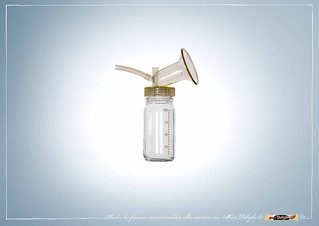And just because someone has the opposite problem, doesn’t mean that oversupply isn’t a problem in its own right.
This was originally posted on the blog of Pittsburgh area doula and childbirth educator Vanessa T.

Fighting the Battle Against Oversupply
With less than half of women breastfeeding at the six month mark we have to assume that many women believe they don’t make enough breast milk. But what about the others? The ones at the other end of the spectrum, making enough to feed a small village of babies? As one of these women, I can say that we are often told to be grateful for it because women who don’t make enough would be happy to have our problem. Well… I’m here to say that oversupply ain’t all it is cracked up to be. And just because someone has the opposite problem, doesn’t mean that oversupply isn’t a problem in its own right.
Oversupply isn’t just about having too much milk. If that was all there was to the problem, it probably wouldn’t be a problem. Oversupply is usually accompanied by a letdown that causes mom to spray milk at a high rate, which causes the baby to choke and swallow air. What eventually happens is that the baby fills up on the milk, which contains very little fat and air and this leads to gas and stomach pains. This causes the baby to appear colicky and have explosive gas and bowel movements. And also want to nurse constantly, perpetuating the cycle of oversupply and colic.
My oldest daughter had colic. It lasted way beyond the typical three months. In fact most of her first year is a blur due to her constant crying and nursing. My middle daughter didn’t have it, mostly because I was still nursing her older sister as a toddler and she helped mitigate any extra milk. When my milk came in, three days after the birth of my youngest, I recognized the signs of strong letdown immediately.
We tried block feeding (nursing on only one side per session) for several weeks. This along with positioning the baby above my breast really didn’t seem to help at all. I resorted to pulling her off when my milk let down and spraying into a cloth then relatching her. But women have multiple letdowns during each nursing session, so this was extremely inconvenient when not at home. I was desperate for answers… so I turned to Dr. Google and came across a very interesting study in the International Breastfeeding Journal.
The Protocol
You can read the study for free here. But basically the protocol consists of pumping your breasts dry. I used a hospital grade pump from A Mother’s Boutique, but I’m sure you could use a regular double electric pump. Followed by a nursing session where the baby nurses freely from each side. This lasted several hours! And was followed by a very deep, comfortable sleep by my baby. When she woke up, I began nursing from one side and stayed on that side for 3-4 hours. Then I switched for the next block and continued on for the next week.
Day One
The day after doing this our baby was noticeably less fussy. She also had a really nice poop that she did on her own without much fuss. She was less gassy and easier to nurse. I did experience a bit of engorgement about 30 hours after the initial pumping session. This led to a crazy letdown. But I did not repeat the pump out and just allowed the milk to spray into a towel and then relatched.
Day Two
I was noticeably less engorged, but still full. Again, I had to take her off for the first couple of letdowns during the first nursing session of each block. But other than that, I did notice that my breasts were softer at the end of the block and I was certain she was getting more fat. She was still much less gassy and fussy.
Days Three and Four
I almost never have to take her off for any letdowns. I am leaking way less during feedings and even though I have spontaneous letdowns in between nursing sessions, I don’t leak at all during them. Her gas is back to a normal amount for a baby. She is still not really pooping regularly, but I no longer feel worried that it is due to an imbalance of too much fore milk.
Day Five (today)
No engorgement and my breasts always feel soft. I never have to take her off for letdown and my leaking is almost nonexistent. She was a little more fussy and gassy last night and today, but I suspect the six week growth spurt is the culprit. We are planning to return the pump tomorrow or Thursday because I am sure I won’t need to repeat the draining.
I am so happy that I discovered this study. It does not seem to be well known because the Breastfeeding Center of Pittsburgh consultant that I spoke to had never heard of it. I hope that writing about it on my blog will help others find it.
Nothing on API’s website should be construed as medical or legal advice. API articles are provided for information purposes only. Consult your healthcare provider for your individual health and medical needs and attorney for legal advice.
